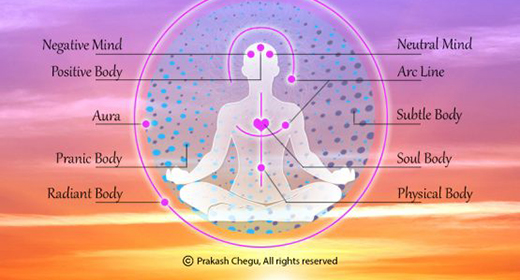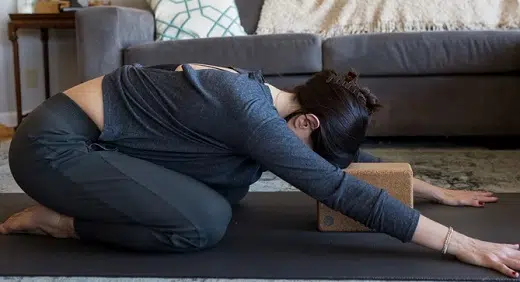by Robin Fasano: Grief yoga expert Paul Denniston reveals a compassionate practice for healing from grief…
Grief gets lodged in the body. As the common adage puts it: The issues are in the tissues. Our body stores and remembers everything on the cellular level. To process our pain, our emotions need to move.
Paul Denniston is the founder of Grief Yoga and author of the book Healing Through Yoga: Transform Loss into Empowerment. He has taught grief yoga to over 10,000 healthcare professionals and counselors, including hospice and cancer-support groups. Denniston explains that the poses of yoga foster healing because they “help you find safety in the body.” And with safety, you can befriend your feelings and ultimately transform them.
He developed what he calls “a compassionate practice” designed for healing grief. It consists of five stages: awareness, expression, connection, surrender, and evolution. Each stage incorporates postures, movements, and sound to help you navigate the path forward and find peace.
Work the steps at your own pace—there’s no rush. Take time to move through the cycle again and again.
Here, he explains the stages and shares grief yoga techniques to cope with and mend the pain of loss.
Awareness
Awareness is the first step of healing. “Awareness is being present to the sensations in your body,” says Denniston.
He points out that when emotions such as grief, sadness, and anxiety can’t be integrated and resolved, symptoms can manifest in the body. For instance, we might grind our teeth at night. Maybe we walk around with a constant knot in our stomach, or grief gets stuck in our shoulders and neck as if we’re carrying the weight of loss.
“Where are you holding grief in your body?” asks Denniston.
Identify the place where you feel anger, hurt, disappointment, abandonment, or betrayal. Acknowledge it. Put your hand on the spot, name it out loud. Feel what arises in your body. Just allow. And honor your feelings—develop a relationship with them, suggests Denniston. You transcend difficult emotions by accepting and releasing them.
Expression
“The only way to move through feelings is to express them,” says Denniston. After you’ve identified where you feel the grief, move it through your body with physical movement or sound to discharge it. This helps jettison the pain so it doesn’t stay bottled up and then fester. By getting the feelings out of the body, you clear the way for joy and harmony to enter.
To express grief, try these exercises:
- Use your voice to give it a sound. It can be aarghhh! or a roar or a sigh. Try lifting your arms, gazing up to the sky, and saying out loud, “Why?”
- Or move your body to “shake off” whatever you’re carrying. Shake out your hands in front of you, move your arms and shoulders, twist and turn. Keep moving until you feel you’ve emptied the hurt, says Denniston. Visualize it leaving the body.
- Try Windmill pose. From a standing position, inhale and reach your arms up over your head. On the exhale, fold over at the waist with your arms sweeping down toward the ground and behind you, propelling the pain out. Continue as many times as you’d like.
Connection
The third stage is connection, which brings you back to your inner self—your center. This is a place of renewal. “Listen to your body,” says Denniston, “It will tell you what you need.” Take a couple minutes to be still and silent.
Tap into the quiet place inside of you and soften. Think of something you’re grateful for (maybe it’s the tree in your yard or a cup of tea). Place your hand on your heart. Now offer yourself gratitude—thank yourself for accessing and expressing challenging emotions. Thank yourself for being with your emotions.
Denniston suggests these ways to connect to your center:
- Give yourself a massage. Self-touch is nurturing. The strokes of massage increase circulation, soothe muscle tension, and boost the immune system. (Read: “Ayurvedic Abhyanga: The Benefits of Self-Massage.”)
- Give yourself a hug. Wrap your arms across your chest and hug yourself as an offering of tenderness and kindness.
- Cup your hands in front of you as if you’re dipping into holy water. Bring your hands up to your forehead and say: “I wash in light … With divine water, I bless my mind, body, heart … I bless myself.”
Surrender
“Surrender is the practice of letting go of the struggle in order to find peace,” says Denniston. Instead of clinging to the pain, let go of whatever you’re feeling—hurt, grief, anger—and give it to something larger: God, Divine Spirit, Source, or a Higher Power. The act of surrender promotes trust in a larger force. And with trust comes faith—this opens the door for acceptance and empowerment, he adds.
He recommends these practices to help with letting go:
- The Resting pose. Simply lie down on your stomach on the floor, rest your cheek on the mat, hands by your sides. And say a soft prayer: “Help guide me … Help me surrender.”
- Caterpillar pose. Find a seated position, stretch your legs out in front of you. Bend forward at the hips toward your toes. Fold over your knees. If you’d like, you can bend your knees. Hold for two minutes. Release and straighten your spine upward.
- Savasana. This pose embraces deep stillness and calm. Lie on your back on the mat, arms at your side with palms up, legs flat and straight. Close your eyes. Focus on your breath. As you inhale and exhale “merge into one with the support that surrounds you and rest.” Continue in this grief yoga pose as long as you’d like.
Evolution
With evolution, you’ve come out the other end and you’re bringing everything together to create something new. “Grief doesn’t get smaller. But we get bigger,” notes Denniston. Grief brings wisdom. Loss grows your courage and expands your being. It deepens who you are and develops your resilience.
Channel your newfound inner resources and heartbreak “to create a spark” to help you move forward in your grief yoga practice in a meaningful way, recommends Denniston. Ask yourself, How do I want to live? What nourishes me? What new life do I want to begin?
Use your unique experiences and gifts in service to others. “You’re here for a reason,” he affirms.
Read an excerpt from Healing Through Yoga: “The Branches of Grief Yoga.”
For more unique yoga practices for the body and soul, read: “The Benefits of Yin Yoga.”










































